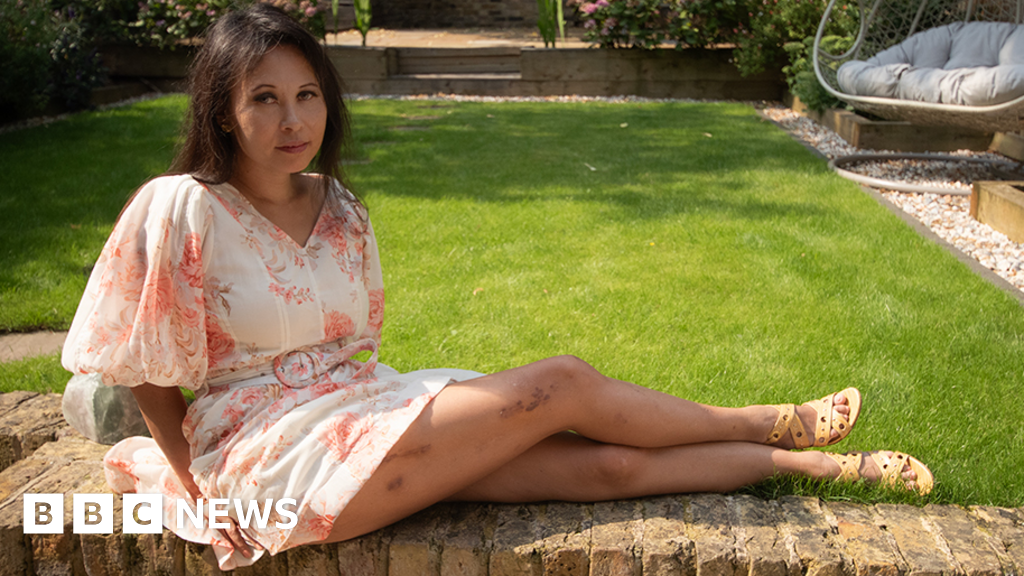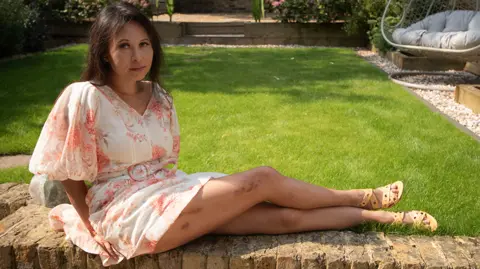 Elaine Fu/Courtesy
Elaine Fu/CourtesyWARNING: This article contains medical details that some readers may find disturbing.
Elaine Fu’s legs are covered in thick purple scars, each a reminder of a leg-lengthening operation gone horribly wrong.
The 49-year-old has undergone five surgeries and three bone graft procedures since 2016, draining her life’s savings and suing the surgeon, which was finally settled in July without any admission of liability.
At one point, Elaine said metal nails broke through her bone and at another time her foot felt like it was “burning from the inside”.
“My journey has been challenging, but I survived,” she says.
Her doctors have consistently denied any wrongdoing and say some of the problems arose from complications she had been warned about, and some from her own actions.
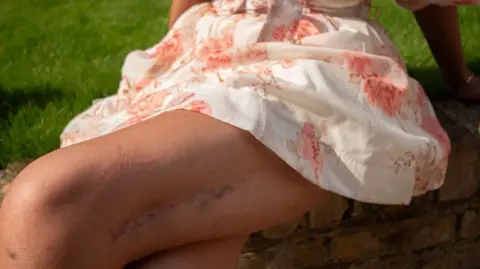 Elaine Fu/Courtesy
Elaine Fu/CourtesyElaine had always hated her height.
“When I was 12, I was taller than most girls,” she says, “and then when I was 14, all of a sudden I was shorter than everyone else. Over time, it became my obsession. Taller is better. Taller is more beautiful. I felt like taller people had more opportunities.”
By the time I reached adulthood, the obsession had become overwhelming.
Elaine believes she had body dysmorphic disorder (a mental illness in which a person feels there is something flawed about the way they look, regardless of how others see them), and the effects of this condition are devastating.
When she was 25, Elaine stumbled across an article about a clinic in China where people were getting surgery to lengthen their leg bones. The article described gruesome details, including medieval-style leg cages and rampant infections. It was the stuff of nightmares, but Elaine was intrigued.
“I know people will question the vanity,” she says, “but when I’m confronted with body dysmorphia, I can’t rationally explain why I feel so horribly bad.”
Sixteen years later, Elaine found a private clinic in London offering the procedure, performed by Jean-Marc Guichet, an orthopedic surgeon who specializes in limb lengthening and even developed his own unique lengthening device, the Guichet nail.
“It was a real hallelujah moment – I was able to have the surgery in London and recover at home,” she recalls.
“Dr. Guichet was very forthright about what could go wrong: nerve damage, blood clots, the bone not healing back together.”
“But I did my research and I was going to very expensive doctors and I expected the medical care to match. My dream was to grow from 5ft 2ins (1.57m) to 5ft 5ins (1.65m).”
On July 25th she underwent surgery at a cost of around £50,000, beginning a process that would change her life.
Leg-lengthening surgery is relatively rare but is available at private clinics around the world, and can cost anywhere from £15,000 to over £150,000 depending on where the procedure is performed.
 Elaine Fu/Courtesy
Elaine Fu/Courtesy“When I woke up I was so excited it was like nothing had happened. I wasn’t in any pain. But 90 minutes later the pain started. It felt like someone was cooking my leg. It was like I was being burned from the inside. The first night I screamed until 6am and fell asleep screaming.”
Some pain is expected during this procedure. During the procedure, the leg bone is broken in two and a metal rod is placed between them.
The metal rod gradually expands in length, separating the halves of the bone. The procedure is intended to increase the patient’s height. The broken bones gradually heal, closing the gap between them.
The operation is complex and is just the beginning of a long process.
“It takes two to three months to lengthen the bone and then at least twice that time for full function to be restored,” warns Professor Hamish Simpson, a former council member of the British Orthopaedic Association, “and for most people it will take a year of their life.”
Once the surgery was over, the process of growing Elaine’s nails began. She would continue the uncomfortable exercise of rotating her foot multiple times a day to activate the rod’s ratcheting mechanism, lengthening the nail and helping her foot grow. But after two weeks, she says, disaster struck.
“I had been experiencing severe pain in my left leg. One night, as I was moving in bed, I heard a noise like a Kit Kat being crushed, followed by a wave of intense pain.”
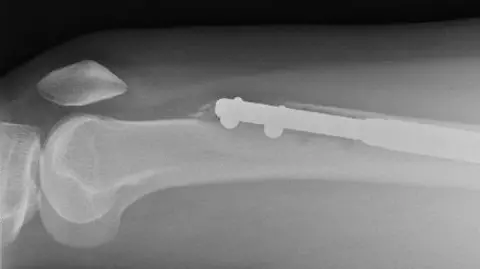 Elaine Fu/Courtesy
Elaine Fu/CourtesyElaine went for a scan, which confirmed her fears: the nail in her left leg had penetrated the femur, the strongest bone in the body. She was distraught, but said Dr Guichet reassured her.
“The doctor said there’s no need to worry right now. We’ll just wait for it to heal and then we’ll start treatment again.”
As doctors continued the operation to lengthen Elaine’s right leg, they scheduled a separate operation on her left leg, which would eventually be lengthened to the same length as her right.
Elaine said she was told the further surgery would cost thousands of pounds but was happy to pay if it meant she could see it through to the end.
By September, her right leg had reached the seven centimetre target. But things weren’t looking good: the difference between her right and left legs was causing problems, her spine was curving and she was in constant pain.
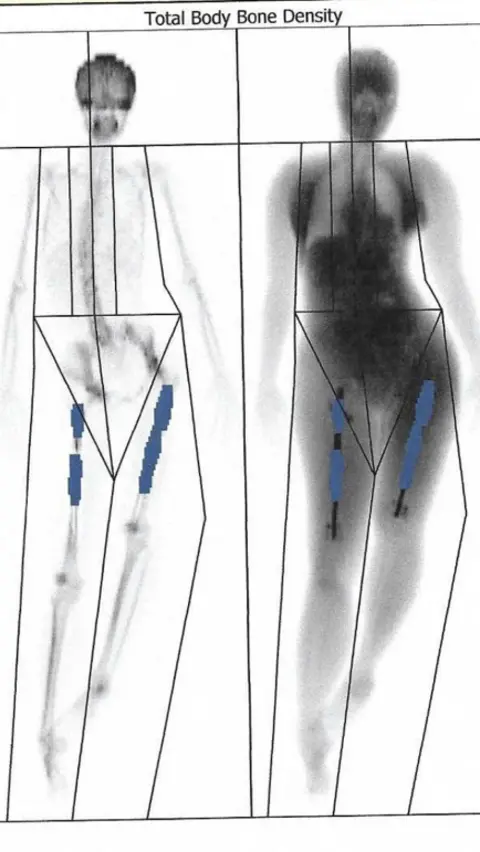 Elaine Fu/Courtesy
Elaine Fu/CourtesySix weeks later, a scan of her right leg revealed a severe lack of bone growth: her femur was essentially two pieces of bone held together by a metal rod.
Elaine sought help from Dr. Guichet, who scheduled another operation at his clinic in Milan. In April 2017, doctors resumed the operation to lengthen Elaine’s left leg, while also injecting bone marrow to stimulate bone growth in her right leg. After the operation, Elaine woke up to more bad news.
“Dr. Guichet told me the nail broke while he was trying to remove it,” she said. “He had a nail from another patient that he was able to put in.” She added that this would cost more.
Three days later, barely able to move but desperate to get home, Elaine returned to London. Communication with Dr. Guichet deteriorated, and by the summer, she felt their doctor-patient relationship had broken down.
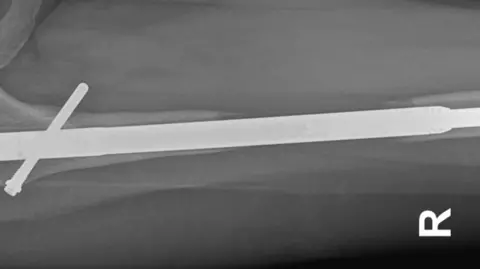 Elaine Fu/Courtesy
Elaine Fu/CourtesyShe didn’t know where else to turn, but by July 2017 she was able to see an NHS orthopaedic surgeon.
Experts told her, “This won’t be a short journey,” she says.
“I was prepared to undergo at least five years of treatment before I fully recovered,” she says.
Eight years after her first operation, Elaine says she is still recovering from the mental and physical scars – she has a range of movement disorders and suffers from PTSD.
“From 2017 to 2020, I hid from the world. I was single, unemployed, penniless and disabled.”
But recently, she has begun to come to terms with the situation. A four-year legal battle finally ended in July when Dr. Guichet agreed to pay Elaine a “substantial” amount to settle her claims. Elaine did not admit liability.
The surgeon’s lawyers denied that Dr Guichet was negligent, telling the court: “Dr Guichet’s case is that he was not negligent, that the fracture and delayed bone healing were unfortunate, non-negligent complications of which Ms Foo was warned prior to the operation, and that the limited bone regrowth on the right side was caused by Ms Foo’s covert use of antidepressants and the deliberate extension of the nail in her right foot beyond the agreed length.”
He also alleged in court that Ms Foo “frequently refused” to follow Mr Guichet’s advice and neglected her rehabilitation and physiotherapy.
Elaine refutes all these claims, saying antidepressants had nothing to do with her complications and that doctors are to blame for what happened to her.
Elaine thought she was safe because she had paid a lot of money, but the price she paid wasn’t just financial.
“I missed out on the best years of my life. I know people want to hear the word regret. If someone asked me today, ‘If you’d known this was going to happen, would you have done it?’ I would answer emphatically, ‘No, thank you.'”
